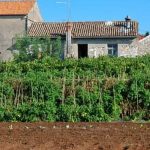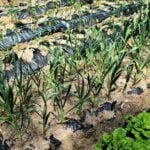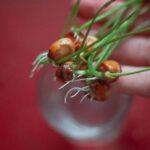Growing your own vegetables is not just limited to those with spacious gardens. In fact, more and more people are turning to growing vegetable gardens in pots, making it possible for anyone, regardless of their living situation, to enjoy the satisfaction of harvesting their own homegrown produce. This introduction will explore the various benefits of container gardening and why it has become a popular choice for those with small spaces or no traditional garden at all.
One of the main advantages of growing vegetable gardens in pots is its suitability for small spaces or urban environments where access to open land is limited. With pots, planters, and raised beds, you can transform even the tiniest balcony or patio into a flourishing garden paradise.
Additionally, container gardening allows you to have complete control over soil quality, water usage, and pest management. This means you can tailor your growing conditions to suit the specific needs of each plant, resulting in healthier and more productive crops.
Selecting the right containers for your vegetables is crucial for successful container gardening. There are various types of containers available – from traditional clay pots to modern planters made from different materials – each with their own set of pros and cons. It’s important to consider factors such as size, material, drainage capabilities, and even aesthetics when choosing containers that will best support healthy root development and overall growth.
In the following sections of this article, we will dive deeper into topics such as choosing the best vegetables for container gardening, preparing the right potting mix, planting and caring for your vegetables in pots, managing pests and diseases organically, harvesting your homegrown produce effectively, overcoming challenges commonly faced in container gardening, and maximizing success through proper planning techniques.
Whether you have a small backyard or simply want to make use of available space on your porch or windowsill, growing vegetable gardens in pots offers countless possibilities. From exploring different types of containers to discovering which vegetables thrive in limited spaces – this article will provide you with all the information you need to embark on your own container gardening adventure.
Selecting the Right Containers for Your Vegetable Gardens
When it comes to growing vegetable gardens in pots, selecting the right containers is crucial for the success of your plants. There are several types of containers available, each with their own pros and cons. Here are a few options to consider:
- Pots: Pots are the most common type of container and come in a variety of sizes and materials such as plastic, terracotta, or ceramic. They are portable and easy to move around if needed. However, they can be limited in space for root growth, so it’s important to choose larger pots for larger vegetables.
- Planters: Planters are similar to pots but generally larger in size. They often have built-in drainage systems and may even come with trellises or support structures for climbing plants like tomatoes or beans. Planters also provide more depth for root growth compared to regular pots.
- Raised beds: Raised beds are an excellent option if you have limited space on the ground or poor soil quality. These containers can be made out of wood, bricks, or concrete blocks and offer plenty of space for multiple vegetables to grow together.
Regardless of the type of container you choose, there are a few factors to keep in mind when selecting the right one for your vegetable garden:
- Size: Consider the mature size of your vegetables and choose containers that will provide enough space for their roots to grow.
- Material: Different materials have different insulating properties that can affect the temperature of the soil inside. For example, terracotta pots absorb moisture from the soil faster than plastic ones.
- Drainage: Proper drainage is vital to prevent waterlogged soil, which can lead to root rot. Look for containers with drainage holes at the bottom or make sure you can create them yourself.
In addition to selecting the right containers, it’s important to think about aesthetics and how they fit into your overall gardening design. Remember that whatever container you choose should complement the style and look of your outdoor space.
Choosing the Best Vegetables for Container Gardening
Container gardening opens up a world of possibilities for growing vegetables in small spaces or even without a traditional garden. However, not all vegetables are suited for this type of gardening. When selecting vegetables for container gardening, it’s important to consider their growth habits, sunlight requirements, and root space needs. Here is a list of vegetables that thrive in pots along with some factors to consider:
- Tomatoes: Compact or dwarf varieties like cherry tomatoes or patio tomatoes are ideal for container gardening. They require at least 6-8 hours of full sun per day and need support such as stakes or cages as they grow.
- Peppers: Bell peppers and chili peppers are great choices for containers. They prefer warm temperatures and need full sun exposure. Choose compact varieties to save space.
- Salad Greens: Leafy greens like lettuce, spinach, and arugula can be successfully grown in pots. They can tolerate some shade but still need several hours of direct sunlight daily.
- Herbs: Many herbs do well in containers since they don’t require much space to grow. Some popular options include basil, parsley, rosemary, and mint.
- Carrots and Radishes: These root vegetables are suitable for containers if you choose shorter varieties specially bred for container gardening.
When selecting your vegetables, pay attention to their space requirements and make sure to provide enough room for their roots to spread out comfortably in the container.
In addition to the vegetables listed above, other options for container gardening include cucumbers (dwarf varieties), beans (bush types), peas (dwarf varieties), and even small fruits like strawberries or blueberries.
Remember that proper care such as watering regularly, providing sufficient nutrients through fertilization, and monitoring pests is crucial for the success of your vegetable garden in pots. With careful selection and attention to their needs, you can enjoy a bountiful harvest of fresh and healthy homegrown vegetables, even in limited spaces.
Essential Steps for Preparing Your Potting Mix
Preparing the right potting mix is essential for the success of your vegetable gardens in pots. A well-draining and nutrient-rich mix will provide the necessary support and nourishment for your plants to thrive. Follow these essential steps to prepare the perfect potting mix for your containers.
- Choose the Right Base: Start by selecting a high-quality soil mix as the base for your potting mix. Avoid using garden soil as it may contain pests or diseases that can harm your plants. Instead, opt for a commercial potting mix or create your own by combining equal parts of peat moss, vermiculite, and perlite. These ingredients create a lightweight and well-draining base that promotes healthy root growth.
- Enhance with Organic Matter: Add organic matter, such as compost or well-rotted manure, to improve the nutrient content and water-holding capacity of your potting mix. This will help provide a steady supply of nutrients to your plants throughout their growth cycle. Aim to incorporate about 20-30% organic matter into your mix.
- Incorporate Fertilizer: To ensure your plants receive adequate nutrition, include slow-release fertilizer in your potting mix. Look for a balanced fertilizer specifically formulated for vegetables or use an organic option like compost tea or fish emulsion. Follow the manufacturer’s instructions for proper application rates.
- Check pH Levels: Before filling your containers with the potting mix, test its pH levels using a pH testing kit from a garden center. Most vegetables prefer slightly acidic soil with a pH range of 6 to Adjust the pH if necessary by adding sulfur (to lower pH) or lime (to raise pH) according to package instructions.
| Ingredient | Proportion |
|---|---|
| Commercial potting mix | 50% |
| Peat moss | 25% |
| Vermiculite | 12.5% |
| Perlite | 12.5% |
| Compost or well-rotted manure | 20-30 % |
| Slow-release fertilizer | Follow manufacturer’s instructions |
With a well-prepared potting mix, your vegetable plants will have the foundation they need to grow healthy and produce bountiful harvests. By providing them with the right balance of nutrients, drainage, and pH levels, you can ensure optimal growing conditions in your containers. Remember to periodically check the moisture level of the mix and adjust watering accordingly to keep your plants hydrated without causing waterlogging.
Planting and Caring for Your Vegetables in Pots
Plants need care and attention to grow healthy and productive, and vegetable plants in pots are no exception. In this section, we will provide step-by-step instructions on planting seeds or seedlings in containers, along with tips for proper spacing, watering, and feeding of vegetable plants in pots. Additionally, we will offer guidance on providing support structures or trellises for vertical growing in limited spaces.
When planting vegetables in pots, it is essential to select the right container size for each plant. This ensures that the roots have enough space to grow and access nutrients. As a general rule, larger plants such as tomatoes or peppers will require deeper containers with at least a 5-gallon capacity. On the other hand, smaller plants like lettuce or herbs can thrive in smaller pots.
It’s important to choose a well-draining potting mix that allows excess water to flow out of the container while retaining enough moisture for healthy plant growth. Garden soil should be avoided as it can become compacted and hinder root development. Instead, consider using a lightweight potting mix consisting of peat moss, vermiculite or perlite, and compost.
Once you have chosen your container and prepared your potting mix, it’s time to plant your vegetables. Whether you are starting from seeds or seedlings, ensure that the soil is evenly moist before sowing or transplanting. Follow the recommended spacing guidelines provided on seed packets or plant labels to give each plant enough room to spread its roots.
Watering is crucial for the success of potted vegetable gardens as they dry out faster than plants grown in the ground due to their limited soil volume. Check the moisture level daily by sticking your finger into the soil up to your first knuckle. If it feels dry at that depth, water thoroughly until it runs out of the drainage holes at the bottom of the container.
Feeding your vegetable plants with a balanced fertilizer is necessary for optimal growth and productivity. There are various options available, including organic and synthetic fertilizers. Follow the package instructions for application rates and frequency, as overfertilization can lead to nutrient imbalances or burn the roots.
As your plants grow, some may require additional support to prevent them from toppling over due to their weight or height. Install stakes, cages, or trellises in advance to provide a sturdy structure for vine-like vegetables such as tomatoes, beans, or cucumbers. This not only saves space but also improves air circulation and helps reduce the risk of diseases.
| Container Size | Recommended Vegetables |
|---|---|
| 5-gallon or larger | Tomatoes, peppers, eggplants |
| 3-gallon or smaller | Lettuce, herbs, radishes |
Managing Pests and Diseases in Container Vegetable Gardens
Identifying Common Pests and Diseases
Just like plants in traditional gardens, container-grown vegetables are also susceptible to pests and diseases. However, the confined environment of containers can sometimes make it easier to manage these issues. It’s important to be vigilant and identify any problems early on to prevent them from spreading and causing significant damage to your plants.
Some common pests that may affect vegetables in pots include aphids, slugs, snails, and caterpillars. These pests can cause damage by feeding on plant tissues or transmitting diseases. Additionally, certain diseases such as fungal infections or powdery mildew can thrive in the warm and humid conditions commonly found in container gardens.
It is crucial to regularly inspect your vegetable plants for signs of infestation or disease. Look out for holes in leaves, discolored patches, wilting, or abnormal growth. By identifying the problem early on, you can take appropriate measures to combat it before it spreads further.
Natural and Organic Pest Management Solutions
When it comes to managing pests and diseases in your container vegetable garden, opting for natural and organic solutions is beneficial for both the environment and your health. Chemical-based pesticides can have harmful effects on beneficial insects and pollinators, not to mention potential risks associated with consuming produce treated with these chemicals.
One effective method is using companion planting – growing certain flowers or herbs alongside your vegetables that repel pests or attract beneficial insects. For example, marigolds are known to deter aphids while attracting pollinators like bees. Nasturtiums can act as a trap plant for caterpillars, diverting them away from your vegetables.
Another popular organic pest management technique is handpicking pests off plants. If you notice slugs or caterpillars feasting on your crops, simply remove them by hand and dispose of them away from the garden area.
Additionally, homemade remedies such as garlic or chili pepper sprays can be used to deter pests. These natural deterrents can be easily made by combining minced garlic or chili peppers with water and spraying the mixture onto the leaves of affected plants.
Preventing Diseases and Promoting Plant Health
To prevent diseases in your container vegetable garden, it is essential to maintain good plant health. This includes providing adequate sunlight, watering properly, and ensuring proper air circulation around your plants.
Overwatering is a common mistake that can lead to root rot or fungal infections. To avoid this, make sure your containers have drainage holes and water only when the top inch of soil feels dry to the touch. It’s also important to avoid overcrowding your containers, as crowded plants create humid conditions that are conducive to disease development.
Regularly remove any dead or diseased plant material from your garden to prevent the spread of pathogens. Pruning or thinning your plants can also help increase airflow, reducing the chances of disease.
By implementing these pest management strategies and promoting plant health, you can effectively reduce the risk of pests and diseases in your container vegetable garden. With careful attention and timely interventions, you’ll be well on your way to enjoying healthy and bountiful harvests from your potted vegetables.
Harvesting and Enjoying the Fruits of Your Labor
When it comes to growing vegetable gardens in pots, there’s nothing more rewarding than being able to harvest and enjoy the fruits of your labor. After dedicating time and effort into caring for your plants, it’s finally time to reap the rewards. In this section, we will provide guidance on how and when to harvest your vegetables grown in containers, as well as creative ideas for using homegrown produce in delicious recipes and meals.
Harvesting Vegetables
The key to harvesting vegetables at their peak is knowing the right time to pick them. Each type of vegetable has specific indicators that signal they are ready for harvest. For example, leafy greens like lettuce and spinach should be harvested when the outer leaves reach full size but before they start to wilt or turn yellow. On the other hand, tomatoes should be picked when they are fully ripe and have a deep color.
To harvest your vegetables properly, use clean gardening shears or a sharp knife to cut the produce from the plant. Avoid pulling or twisting as this can damage both the plant and its roots. It’s important to handle the harvested vegetables with care to prevent bruising or any other damage that may reduce their shelf life.
Using Homegrown Produce in Recipes
One of the greatest joys of growing vegetable gardens in pots is being able to use your homegrown produce in delicious recipes and meals. The flavor and freshness of homegrown vegetables can transform any dish into something truly special. Here are some creative ideas for using your garden-fresh bounty:
- Salads: Toss together a refreshing salad using a mix of freshly harvested lettuce, cherry tomatoes, cucumbers, and herbs.
- Stir-fries: Incorporate colorful bell peppers, snap peas, carrots, onions, and zucchini from your container garden into a flavorful stir-fry.
- Salsas and Dips: Blend freshly harvested tomatoes, onions, peppers, and herbs to create your own homemade salsa or dip.
- Roasted Vegetables: Coat a variety of root vegetables like carrots, potatoes, beets, and parsnips with olive oil, seasonings, and herbs before roasting them in the oven for a tasty side dish.
- Smoothies: Add homegrown fruits like strawberries or blueberries to your smoothies for an extra boost of freshness and flavor.
By incorporating your homegrown produce into your daily meals, you not only enjoy the taste of truly fresh vegetables but also maximize the satisfaction you get from your container garden. Additionally, using homegrown ingredients in your cooking allows you to have full control over the quality and safety of the food you consume.
Overcoming Challenges and Maximizing Success with Container Gardening
Container gardening offers many advantages for individuals with limited outdoor space or the absence of a traditional garden. Despite these benefits, there are certain challenges that may arise when growing vegetable gardens in pots. However, with the right knowledge and strategies, these challenges can be overcome, resulting in a flourishing and successful container garden.
One common challenge faced by container gardeners is the issue of limited space. Fortunately, there are several ways to maximize space in your small garden. Consider using vertical gardening techniques, such as installing trellises or supports for vining plants like tomatoes or cucumbers. Additionally, you can practice succession planting by rotating crops throughout the growing season to ensure a continuous harvest and make the most of your limited space.
Another challenge to consider is maintaining proper moisture levels and water drainage in containers. To address this issue, it’s crucial to select containers with adequate drainage holes and use well-draining potting mix. Regular watering is also crucial to keep plants healthy, especially during hot summer months. Remember to monitor soil moisture levels regularly and adjust watering frequency accordingly.
Additionally, container gardens may be more susceptible to temperature fluctuations compared to traditional gardens planted directly in the ground. During extreme weather conditions, such as heatwaves or frosty nights, it’s important to protect your plants with shade covers or fleece blankets if necessary. This will help regulate temperatures and shield your plants from damage.
While container gardening presents its unique set of challenges, it offers an abundance of rewards for those who put in the effort. By following these troubleshooting tips and implementing smart strategies like succession planting and proper watering techniques, you can overcome obstacles and achieve bountiful yields from your potted vegetable garden.
In conclusion, container gardening allows individuals with limited space or no access to traditional gardens the opportunity to grow their own fresh vegetables. By selecting suitable containers, choosing appropriate vegetables for container gardening, preparing nutrient-rich potting mix, caring for plants properly, managing pests effectively, and harvesting the fruits of your labor, you can create a thriving and successful vegetable garden in pots. With perseverance and these expert tips, you can overcome challenges and maximize your success in container gardening.
Frequently Asked Questions
Which vegetables are best to grow in pots?
When it comes to growing vegetables in pots, some of the best options are those that have compact roots and do not require deep soil. Herbs like basil, parsley, and chives are excellent choices as they thrive in small containers.
Leafy greens such as lettuce, spinach, and kale also do well in pots since their shallow root systems don’t need extensive space. Other vegetables like radishes, carrots, and small varieties of peppers or tomatoes can be suitable for container gardening too, but it’s important to choose dwarf or compact varieties that won’t outgrow the pot.
How deep do pots need to be for vegetables?
The depth of pots required for growing vegetables may vary depending on the specific vegetable being planted. Generally speaking, most vegetable plants need a minimum depth of 8-12 inches (20-30 cm) to allow their roots to grow and develop properly.
However, larger root crops like carrots or potatoes may need deeper pots ranging from 12-18 inches (30-45 cm) to accommodate their longer roots. It’s essential to provide enough space for the roots to spread without restriction so that the plants can access moisture and nutrients effectively.
How do you prepare soil for planting vegetables in pots?
Preparing the soil for planting vegetables in pots is crucial as it plays a vital role in supporting healthy growth and providing necessary nutrients. Start by selecting a high-quality potting mix specifically formulated for container gardening rather than using garden soil alone. This ensures good drainage while retaining adequate moisture for plant roots.
Before planting, loosen up the potting mix with your hands or a garden fork to remove any clumps and create a light texture that allows air circulation. Additionally, you can incorporate organic matter like compost or well-rotted manure into the mix to enrich it with nutrients essential for plant growth. Remember to thoroughly moisten the soil before sowing seeds or transplanting seedlings as this helps kickstart growth while ensuring optimal hydration throughout the growing period.

If you’re looking to get into vegetable gardening, or are just looking for some tips on how to make your current garden better, then you’ve come to the right place! My name is Ethel and I have been gardening for years. In this blog, I’m going to share with you some of my best tips on how to create a successful vegetable garden.





